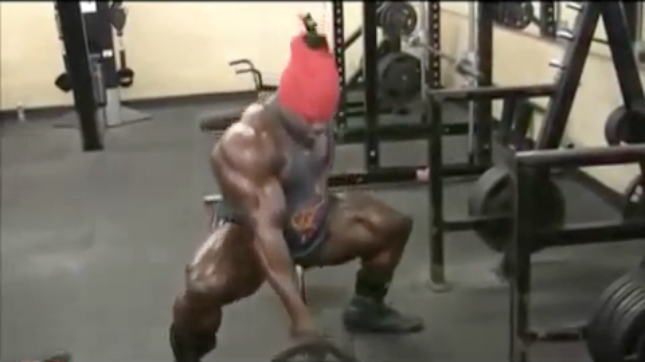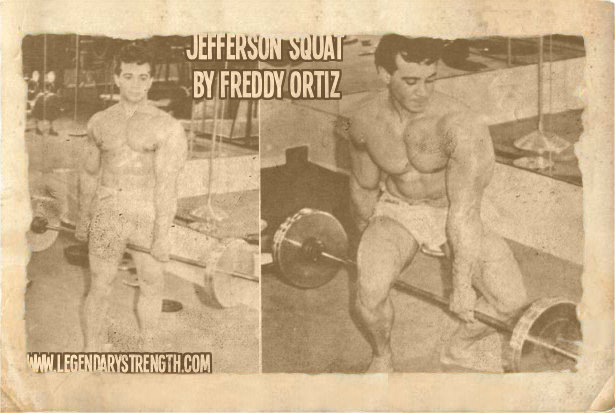Best Exercise in Ever: Jefferson Deadlift
I’ve used this lift sparingly in the past, I would say about 8 years, and probably more as a mobility drill than a strength exercise. I found it was a great way to encourage people to get their knees open for a wider stance in their squats, build some rotational range of motion, and take people outside of a pure saggital plane movement dominance pattern. That, and it’s a pretty bad ass looking exercise, as evident by this pic of Mr. Olympia competitor Kai Greene, who is a big fan of the lift in his leg training.
Recently, I read an article by Dave Dellanave about how the Jefferson deadlift is one of the main lifts he prescribes to people, and I was intrigued. Similarly as to how I’d used low resistance hip thrusts as more of a low threshold and glute endurance activity before coming across Bret Contreras’ work with the heavier loading, it started to make sense that the carryover could be something pretty impressive with using the Jefferson deadlift as more of a strengthening exercise than keeping it as a mobility drill.
The biomechanics of the lift are fairly straight forward. Your center of gravity is vertical over the load, and your feet straddle the bar to provide a larger base of support by which to generate force. In a conventional deadlift, you have the majority of the weight behind the bar, and the base of support is relatively small compared to the Jefferson. The sumo stance has a wider base, but again the majority of weight is behind the bar at set up, which means leaning and increasing shear forces on the low back. Using a Jefferson stance, you can increase the vertical position of the spine, and allow more compressive forces and less shear forces, which makes it an easier exercise for guys with jacked up low backs like yours truly.
If the name of the game is increasing the weight you can lift, and the basic approach to lifting weight is to take advantage of leverage in any way possible, having your centre of gravity vertical over the load and having a larger base of support improves leverage, which means it should be a lift you can generate more strength through.
I tried it out the yesterday, cold, and still in my work uniform, just to see what would happen with heavier loading.
[youtuber youtube=’http://www.youtube.com/watch?v=N1LZA-EB8mE’]
Starting with 225, then 315, each for 3 reps, I went with a double overhand grip. I did one at 405 with a double overhand grip as well, but my grip failed on me when I got to about half thigh, and I wound up almost dropping the damned thing. I switched to a mixed grip for the rep at 405 shown, and I have to say, it felt pretty easy, considering it was 405 and my lifetime max is 455 in a conventional pull. I would say it was roughly a 7/10 effort. I was taking it slow as more of a feeling out process to see what I felt working and wether I liked it or not. I did.
Prior to this, I tested out a few things using a hand grip dynamometer to see what stance and grip pattern provided the best feedback to where my best positioning would be. I detailed a little of the reasoning behind this HERE, so check that out when you can. In the end, I found that having my right foot forward, and my left hand gripping in an underhand grip was the best option, combined with a foot position where my feet were nearly 90 degrees to each other, and I had a recipe for my ideal Jefferson deadlift.
I’m pretty sure I could do some serious weight with this variation, given that there was no strain in my low back, it felt relatively strong, and as mentioned before, given the weight it still felt relatively easy. Maybe 500 pounds isn’t far off?
How to Do It
The cool thing about a Jefferson deadlift is because it’s a fairly awkward lift, everyone will have a slightly different way of approaching it, which means picking it apart isn’t very effective. The basics are as follows:
- Straddle the bar
- grab the bar
- stand up with the bar
- fist pump
More specifically, make sure your spine remains relatively linear so you aren’t rounding or seriously deviating away from a neutral position as much as possible, and make sure when you start pulling your knees don’t collapse towards the midline in a valgus party you do NOT want to be invited to. Last, make sure your knees don’t lock out before your hips get through the movement, otherwise you’ll be doing a really awkward good morning with nothing but your hips hopefully working overtime to make sure your back isn’t about to spit out your spleen across the room.
Try out with the left leg forward, the right leg forward, different grips, and see what works best for you. Work with higher reps, lower reps, heavy weight, lighter weight, and everything in between to get the full benefit of this and any other compound lift.
For more information in unique deadlifting methods and techniques, check out Off the Floor, the new e-book from Dave Dellanave. It’s one of the best reads I’ve ever seen on deadlifting, and it even gave me some serious ideas for training myself and also my clients. It also includes an hour conversation/interview with Bret Contreras on how to dominate the deadlift on technical perfection. The price will double in Sunday, whenever Dave decides to roll out of bed following his wedding on Saturday night. If for no other reason, pick up a copy to help the guy pay for his wedding.
 ====>Get OFF THE FLOOR Now!!<====
====>Get OFF THE FLOOR Now!!<====


6 Responses to Best Exercise in Ever: Jefferson Deadlift